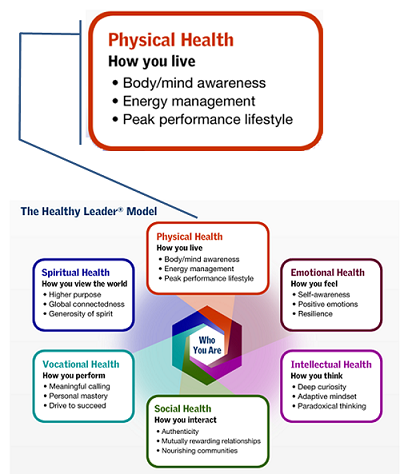When you walk in the room, who shows up for Read more →
The Leader’s Physical Health
Posted Thursday, May 2, 2013Allen Slade
I think of my time as CEO as more of a marathon than a sprint. So, I’ve really been focused on how do I live healthy enough so that I can stay in this high level of energy for a long period of time. I’ve been dieting. I’ve been working out more. I’m 53. I still theoretically have 12 years to go [until retirement].
John Schlifske Chairman and CEO Northwestern MutualLeadership is like a tree. The leader’s accomplishments are the fruits of leadership. The leader’s actions are the visible parts of the tree – the trunk, branches and leaves. But the roots of healthy leadership are defined by who the leader is. Without healthy roots, there will be no fruit and the tree will wither.
In the NFL combine, high potential athletes are asked to run, jump and lift weights to assess their potential to succeed in professional football. To succeed as a leader, you don’t need to max out your 40 yard dash or vertical leap. Instead, leaders need to be energetic, hardy and have the physical capacity to put out the extra effort needed to succeed. In the Healthy Leader® model created by Bob Rosen of Healthy Companies International, the leader’s physical health is the starting point.
Modified from an image courtesy of Healthy Companies Inc.
Let’s consider each of the three aspects of physical health.
Body/Mind Awareness
To be a healthy leader, you need to understand the link between your physical well-being and your thoughts and emotions. You need to make healthy choices and take actions to manage stress and address illness. You also need to enable your team to have a healthy lifestyle, including adjusting work demands that are causing health issues.
Some leaders are naturally attuned to their bodies and have healthy habits. Others, including me, need to be more deliberate. I don’t exercise out of habit, so I look for external motivation. Right now, I am training for a century – a 100 mile bike ride – because the event gives me a goal that motivates me to work out. If you are driven by your schedule, you may benefit from scheduling time for your health. Other people may be motivated by having an exercise partner or trainer.
Where are you as a leader on Body/Mind Awareness? Do you habitually make healthy choices? If not, create a plan to get yourself heading in the right direction.
Energy Management
Jim Clawson says effective leadership is “managing energy, first in yourself, then in those around you.” In some ways, our capacity to do work is like a battery. Some things drain our energy and other things charge us up. Working long and hard drains us, and rest restores our energy. There are key differences among leaders. Extraverts gain energy from social interactions while introverts are drained by meetings and parties. When facing a day of solitary work, introverts can gain energy as the day goes on, while extraverts need to get out and chat to keep their energy level high.
How effective are you at managing your own energy? When your batteries are running low, can you recharge yourself? I sometimes advise coaching clients in high stress jobs “Go fast to go slow, and go slow to go fast.” In other words, slowing down to recharge yourself can reduce errors and rework.
Managing your own energy is only half the game. You must also manage energy in those around you. In times of stress, some leaders act as stress buffers, providing encouragement and practical help when the impossible deadline is looming. Other leaders add stress by micromanaging and projecting their own fear of failure onto their team. A healthy leader is aware of the energy level of others and takes steps to keep the team’s energy up.
How good are you at managing your own energy? How good are you at managing energy in others? If you need to get better at energy management, the first step is simple: Be mindful of energy levels in yourself and others. Notice what adds energy and what depletes energy. As you notice energy more, you will be able to manage energy better.
Peak Performance Lifestyle
Even a fully charged AA battery will not be able to power your kitchen stove. If energy management is about charging up depleted batteries, peak performance lifestyle is about increasing the size of the batteries. The healthy leader is able to manage stress at home and work, get plenty of sleep and make healthy choices to lead for the long haul. The healthy leader also helps team members have a healthy work-life balance.
Some organizations value employee health, and they provide programs – fitness centers, flexible work arrangements, healthy food at work locations – that support healthy lifestyles. Other organizations see employee health as a cost and do the minimum required by law or the labor market. It can be shorted-sighted to deplete your employees’ health to gain short term performance at minimum cost. As an individual leader, don’t be boxed in by your organization’s lack of support for a peak performance lifestyle. You need to strive for your own peak performance. You also need to takes steps to help your team be healthy and perform well.
Bottom line: As a healthy leader, you need to support the physical health of those you lead. To do that, you need to be aware of your own physical health, manage your energy and strive for a peak performance lifestyle.


